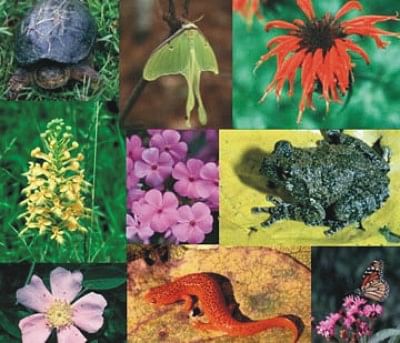Challenges to biodiversity conservation and sustainable development

Biodiversity is the “living foundation” for sustainable development. Now, to make biodiversity sustainable is one thing; and to practice sustainable use of biodiversity is another. Making biodiversity sustainable is the process; and sustainable use of biodiversity is the technique. To us important is that, we shall have to understand the process of making biodiversity sustainable, and the technique to be adopted for its use at the same time.
Sustainable use of biodiversity is measured under the headings -- 'Direct-use value', 'Indirect-use value' and 'Non-use value'. Direct-use value includes food, medicine, biological control, industrial materials, recreational harvesting and ecotourism. Indirect-use value deals with biodiversity and ecosystem functions for maintenance of soundness of environment as a whole. Non-use value provides options value, bequest value, existence value and intrinsic value. All use-values of biodiversity are possible to be sustainable when conservation of biodiversity is made sustainable.
Truly sustainable development requires entities to redefine their policies on land use, food, water, energy, employment, development, conservation, economics and trade. Protection and sustainable use of biodiversity requires the participation of ministries responsible for such areas as agriculture, forestry, fisheries, energy, tourism, trade and finance.
Conservation of biodiversity and its use in sustainable development have been impeded by many obstacles. The need to mainstream the conservation and sustainable use of biological resources across all sectors of the national economy, the society and the policy-making framework is a complex challenge at the heart of the Convention on Biological Diversity(CBD). This will mean cooperation with many different actors, such as regional bodies and organisations. Integrated management of natural resources, based on the ecosystem approach, is the most effective way to promote this aim of the Convention. Provision by developed country Parties of resources to implement the Convention is critical and essential. The Strategic Plan can promote broad-based action by bringing about a convergence of actions around agreed goals and collective objectives.
Major challenges to implementing the conservation of biodiversity and its use in sustainable development are many. Only some selected ones are discussed below.
Population growth and increasing demand for biological resources
As we use biodiversity to meet our demand under the above points, population increase in the world stands as a major problem because it increases consumption creating pressure for using bio-resources more and more. The world is losing its tropical forests at the alarming rate of almost 42 million acres per year. This means that nearly 1.3 acres of tropical forest disappear every second. The largest areas of forest loss occurred in Latin America, followed by Africa. However, when deforestation is measured as a percentage of the remaining forest, the most losses happen to have occurred in Asia. At the current rate tropical forest will be gone within 115 years.
The Bangladesh forest with its exuberant majesty and biodiversity depleted and shrank to 6 per cent from 20 per cent of land area within a time span of 50 years. This happened due to policy weakness, over-exploitation and law and order failures. It is fact that, there is lack of legislation to provide protection to the national forest but poor implementation mechanism of the existing rules perhaps causes a greater damage in this regard.
At the beginning of the British rule, the Indian subcontinent including Bangladesh appeared to hold inexhaustible forest resources. Rennel's map (1886) indicated that the Sundarbans, sal forest of the Bhawal-Madhupur tracts covered an area several times larger than it is at present. The hill forests of Chittagong, CHT, Sylhet, Mymensingh and Comilla were also densely populated by more than 2000 flowering plant species including 300 tree species. Nearly 30 tree species in hill forest, 20 species in plain land forest and 30 species in the littoral forests used to be commercially exploited. In addition, the homesteads were covered with valuable fruit, fodder, timber, fuel wood, bamboo and many multipurpose tree species.
Environmental Biology and Biodiversity Laboratory (EBBL), University of Dhaka has recently made a study on the traditional and cultural involvement of local people and the causes of deforestation in some forest areas of Chittagong and Cox's-Bazar districts. In the study the impact of population growth and increase, demographic statement of the local people involved, family affairs and tradition, and their education systems were taken under consideration. The local people (because they are poor and illiterate) are culturally habituated to go inside the forest every morning and have some wood or undergrowth plants cut for selling in the market nearby.
Exotic species
Introduction of exotic species is another major challenge to biodiversity conservation and its use in development.
In Bangladesh, some plant and animal species have been introduced from different countries. These exotic species have hampered endemic species both in their population dynamics and in the position of their trophic levels. At the same time, in many cases the importation has opted for changing ecosystem. In the aquatic ecosystem, the major introduced species those have changed a lot the ecosystem are African magur (Clarias garipinus) and red Piranha (Pygocentrus natteri). In the terrestrial ecosystem the species are Tectona grandis (Shegun), Acacia spp. Eucaliptus spp. and Swietenia mahagoni.
The forest areas of our country from Karer Hat to Teknaf in the Chittagong division have been dominated by garzon (Dipterocarpus turbinatus) tree as canopy layer since long time; and it is endemically sustained also for long time. The garzon forests have got some important characters for maintaining the three layers of vegetation. First layer of vegetation is with the soil surface and does not come up to the height of more than one meter. They are mainly the grasses and the members of Zingiberaceae family. They keep the soil surface wet. This layer is the suitable shelter for microbes' growth and sustainability. It supports the second layer of vegetation and also the third canopy layer.
Second layer of vegetation is the vegetation of man height level. This is the vegetation layer comprised of vines, grubs, hedges and shrubs plants. These provide enough shade, protection and make favourable conditions for the plants' and microbes' growth of first layer. The layer is called the “Undergrowth Vegetation” in the forest. Third layer is the canopy layer of typical Garzon population or the population with other related trees. Third layer protects the grubs, vines, shrubs and hedges. During the variation of seasons the leaves fall on the ground and the fallen leaves provide enough organic deposition for the growth of both first and second layer of vegetation. In this way the entire typical forest ecosystem in the endemism sustains and survives in a normal and usual situation. If any unusualness appears because of introduction of any exotic species then the change of the ecosystem happens.
In typical aquatic ecosystem of our country (like pond ecosystem), fishes like shingi (Heteropneustes spp.) feed on the chironomid larvae keeping them in the status of fourth trophic level (3rd consumer). The carnivorous fishes of our endemic nature like Chital (Nostosterus spp.) and Boal (Walago spp.) feed on the fishes of fourth trophic level and attain the status of fifth trophic level (fourth consumer). In our typical aquatic ecosystem (pond ecosystem) the energy-flow and ecological pyramids are arranged in this pattern. On the other hand, when African magur (Clarias garipinus) and Red Piranha (Pygocentrus natteri) are introduced to the ecosystem they drastically consume without maintaining the chronology of the ecological pyramid-pattern in an ecosystem. These introduced species drastically reduce the population of animals of all trophic levels and create ecological hazard for the population of all other aquatic animals and many aquatic plants also. Consequently aquatic ecosystem gets changed or “altered”.
Government policies
At least two conditions must be fulfilled if a country has to achieve or at least make significant progress towards the targets of realising biodiversity use in sustainable development. One relates to the capacity of the country to implement policies and programmes effectively. In most developing countries, governance is poor in terms of human capability on one hand and lack of transparency and accountability on the other. It is, therefore, essential that the developing countries take necessary steps to establish good governance, including rule of law and improvement in the economic and social management capacity. In Bangladesh perspective, main constraints for the development are corruption and inadequacy in administration.
Biodiversity conservation has got a great role in maintenance of species richness and proper functioning of an ecosystem. Conservation of biodiversity means the conservation of biotic and abiotic factors together and their interaction to provide the sustainable situation for living organisms in an ecosystem. If the normal proliferation and reproduction of all living organisms and their interaction with abiotic factors fail in an ecosystem, then ecological imbalance remains in its persistence. Persisted ecological imbalance makes the environment unfavourable for initiating any kind of development plan. And this is why the biodiversity conservation stands at epicentre of the sustainability of the global developmental goals and targets.
Habitat degradation
The major threats to biodiversity that result from human activity are habitat destruction, habitat fragmentation, habitat degradation, overexploitation of species for human use, introduction of exotic species, and increased spread of diseases. Most threatened species face at least two or more of these threats, speeding their way to extinction and hindering efforts to protect them. Typically, these threats develop so rapidly and on such a large scale that species are not able to adapt genetically to the changes or disperse to a more hospitable location (Primack, 1998).
Habitat degradation becomes threat to biodiversity in different appearance and dimension. In different countries, the habitat loss is different and causes the loss of biodiversity in different ways. One example could be cited from Cambodia, its habitat loss and its impact on biodiversity depletion. Before the Vietnam War, Cambodia was a quiet, forest-rich country. The war disrupted all aspects of the country's life for 20 years, and the ensuing civil war continued the disruption, with environmental consequences that would be felt for many more years to come. Cambodia has lost approximately three fourths of its wildlife habitat and has put at risk more than half of its wetlands.

 For all latest news, follow The Daily Star's Google News channel.
For all latest news, follow The Daily Star's Google News channel. 



Comments